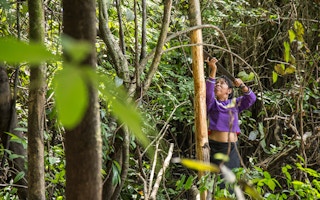In May 2019, a landmark report by the Intergovernmental Science-Policy Platform on Biodiversity and Ecosystem Services painted a bleak picture of our planet’s health. Around one million animal and plant species – more than ever before in human history – are now threatened with extinction, many within decades.
Pollution is proliferating, land degradation is accelerating, and we are nowhere near on track to achieve global goals for protecting biodiversity and achieving sustainability.
But, even as media touted the report’s dire warnings, they largely missed another of its key findings: lands and waters that are owned, managed, and used by indigenous peoples and local communities are much healthier than those that aren’t. A growing body of research supports the clear implication that indigenous peoples have a vital role to play in addressing the biodiversity crisis.
“
In practice, indigenous peoples continue to play a very limited role in biodiversity discussions.
Only recently have international discussions about environmental issues begun to acknowledge the role of indigenous communities.
Over the last year, delegates of the 196 parties to the Convention on Biological Diversity (CBD) participated in countless workshops aimed at producing a new international agreement setting common goals and targets for reversing biodiversity decline, using ecosystems sustainably, and ensuring that the benefits they confer are shared equally.
And in their most recent discussions of the initial draft of the post-2020 framework, the parties recognised the importance of including indigenous peoples in the process. This was an apparent nod to the United Nations Declaration on the Rights of Indigenous Peoples, which promotes our full and effective participation in all matters that concern us.
Yet, in practice, indigenous peoples continue to play a very limited role in biodiversity discussions. The second meeting of the Open-ended Working Group on the Post-2020 Global Biodiversity Framework, held in Rome in February, is a case in point. We sat at the back of the room listening to delegates tout the benefits of indigenous knowledge for protecting nature and debate the legitimacy of our rights to our biodiversity-rich territories.
We worked tirelessly to persuade the parties to include our proposed text in the official meeting record. Though some progress was ultimately made, it will not be nearly enough to address the biodiversity crisis. In fact, we did not hear a single proposal that would spur the paradigm shift that our planet so desperately needs.
In my previous career as a professional forester in British Columbia, I saw firsthand the destruction wrought by unsustainable forestry practices, which reflect a utilitarian approach to nature: the planet and its ecosystems are little more than a source of material wealth. This approach is anathema to indigenous knowledge, culture, and laws – the very factors that explain our superior record of environmental stewardship.
Indigenous peoples’ connection to our lands, waters, air, and other natural resources is deeply embedded in our cultures and traditions. We hold ceremonies to show our gratitude and respect for the natural gifts on which our survival depends. This instills in us a deep understanding of – and commitment to – our duties and responsibilities as nature’s stewards and guardians. We know that we need nature as much as it needs us.
I believe that the world’s failure to embrace such a holistic perspective lies at the root of the imbalances that are propelling our planet’s destruction. We cannot continue to make the same mistakes. And that means following through and building on the commitments contained in the Declaration on the Rights of Indigenous Peoples to protect our rights and engage us fully in discussions of issues affecting us.
Canada offers a promising example. Last November, the government of British Columbia enacted legislation to implement the UN declaration, enshrining our rights to our lands and waters, our resources, and our self-determination.
It is now required in the province to move toward consent-based decision-making and further collaborate with indigenous peoples on any legislative or policy changes that affect our rights. The federal government is set to replicate this legislation at the national level at the end of this year.
More countries should follow this example, enshrining in legal frameworks the rights of indigenous peoples to govern our own territories and practice our knowledge. This means recognising our governments and laws, which are essential to ensure that our knowledge is transmitted through generations for the benefit of biodiversity.
It also means repealing racist laws designed to oppress indigenous peoples. Such protections will go a long way toward strengthening our communities’ resilience and defending the ecosystems we have long protected – sometimes with our lives.
But, if we are truly to protect biodiversity, this approach must also be reflected at the international level. The parties to the CBD will be meeting, either online or in person, next May to finalise a global biodiversity framework for the next decade and beyond. This will determine the fate of the world’s remaining biodiversity – 80 per cent of which is protected by indigenous peoples.
Rather than relegate us, yet again, to observer status, the meeting’s chairs, with the support of the parties, must allow indigenous peoples to make written submissions that, unless openly opposed by a party, will be included in UN documents. We are the original stewards and guardians of this planet. We know how to protect it. It is time for world leaders to listen to us.
Terry Teegee, a member of Takla Lake First Nation, is the British Columbia Assembly of First Nations Regional Chief and a former registered professional forester.
Copyright: Project Syndicate, 2020.
www.project-syndicate.org










